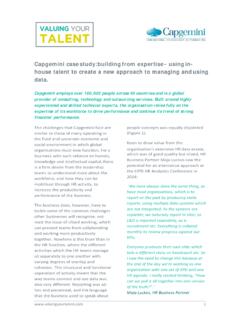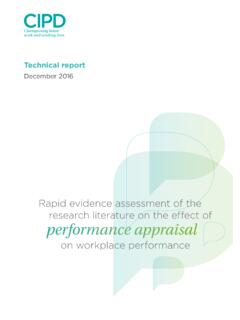Transcription of Avoiding the Demographic Crunch Labour Supply and Ageing ...
1 Policy reportJune 2015 Avoiding the Demographic Crunch : Labour Supply and theageing workforcein collaboration withThe CIPD is the professional body for HR and people development. The not-for-profit organisation champions better work and working lives and has been setting the benchmark for excellence in people and organisation development for more than 100 years. It has more than 135,000 members across the world, provides thought leadership through independent research on the world of work, and offers professional training and accreditation for those working in HR and learning and | Avoiding the Demographic Crunch : Labour Supply and the Ageing workforceAvoiding the Demographic Crunch .
2 Labour Supply and the Ageing workforcePolicy reportContentsExecutive summary 3 Introduction 61 Trends for the UK Labour market 82 Assessing the scale of the challenge for different industries posed by Ageing 153 Adapting to an Ageing and more age-diverse workforce 24 Conclusion 29 Endnotes 302 | Avoiding the Demographic Crunch : Labour Supply and the Ageing workforceAbout the ILCThe International Longevity Centre-UK is the leading think tank on longevity and Demographic change.
3 It is an independent, non-partisan think tank dedicated to addressing issues of longevity, Ageing and population change. We develop ideas, undertake research and create a forum for report is the culmination of a joint ILC-UK, CIPD research project seeking to understand how Ageing will affect different industries. The team at the ILC-UK who conducted the analysis included Ben Franklin, Brian Beach, Helen Creighton and David Sinclair. Ben Willmott, Mark Beatson and Rachel Suff from the CIPD provided helpful comments throughout and drafted the employer-focused on data sourcesThe analysis presented in this report draws on the Labour Force Survey (LFS) available from the UK Data Archive (UKDA).
4 LFS is a survey of private households in the UK intended to gather information related to the Labour market behaviour of the population . It is the largest household survey in the UK and provides the official measures of employment and unemployment. The developers and funders of the LFS, as well as UKDA, do not bear any responsibility for the analyses or interpretations presented | Avoiding the Demographic Crunch : Labour Supply and the Ageing workforceExecutive summaryThere are already million people in employment over the age of 50 in the UK, equivalent to over 30% of the workforce.
5 In future decades, a vast proportion of this group will leave work permanently, taking their acquired skills and experiences with them. Unfortunately, long-term Demographic change means that there is unlikely to be a burgeoning Supply of younger people in the UK who will enter the Labour market to replace retiring workers, while levels of migration are likely to be lower than that experienced over the past decade, further limiting the available talent pool. But while this broader picture seems familiar, the extent to which Ageing could affect different UK industries is not.
6 Key trends which are transforming the nature of workWhile there has been much talk of rebalancing the UK economy away from services and towards manufacturing, the truth is that service industries are highly likely to see their share of GDP rise over future decades rather than fall. The UK s comparative advantage in knowledge-intensive service industries is likely to drive this forward, with a growing emphasis on high-skilled Labour and less reliance on low- and middle-skilled employment. At the same time, there is likely to be a continuation of the shift towards part-time and self-employment, as individuals and particularly older individuals who account for a growing number and share of total employment demand greater flexibility and more autonomy.
7 And of course, a growing cohort of older consumers will also shift the demand for future products and services. population Ageing should not therefore be viewed in isolation of these other moving parts that will affect the Labour market, but as something that will be part of a host of interconnected trends transforming the nature of work itself. What is the scale of the challenge posed by Ageing for different industries? To better understand the scale of the challenge, we undertook detailed analysis of the Labour Force Survey (LFS).
8 Using these data we were able to explore the age profiles of different industries as well as the extent to which industries are currently experiencing a drop-off in employment after certain ages one measure of their ability to keep people in work as they grow older. Our results reveal key differences across industries. For some, there is an urgent need to understand how they will replace a vast proportion of their workforce in the short to medium term due to retirement while, for others, there is a need to understand how jobs traditionally done by younger workers can be filled by middle-aged and older workers in the future.
9 More specifically, our analysis finds that: More than one in ten workers across most industry groups are aged over 60, while more than one in five are over the age of 50. In agriculture and real estate, over 40% of workers are aged over 50. Replacing such a significant proportion of the workforce in the next 20 years is likely to represent a difficult challenge as new recruits will need to learn the skills and expertise of those that have left. It is not just proportions that matter, but absolute numbers too. There are currently over million workers over the age of 50 in health and social work and more than million over 50 in both education and retail.
10 Replacing such large numbers of people will require a significant number of future school-leavers and potentially migrants to fill the gaps left by older workers leaving these sectors. Many industries have a poor record on retaining older workers, seeing a large drop-off in the number of workers between the ages of 45 49 and 60 64. In particular, finance, public administration and ICT all see a drop of greater than 60% between the number of workers they employ in their late forties and in their late sixties. Such falls suggest that these sectors are not doing enough to support longer working lives and will be hampered by the loss of skilled and experienced staff.












